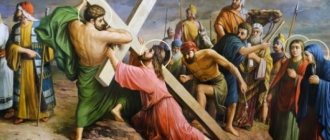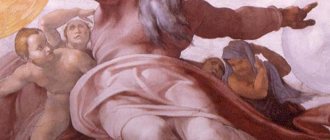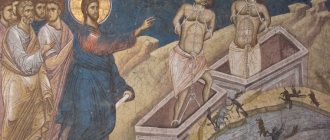Christian apologetics and evidence for the existence of God
Published 05/18/2020
There are at least 9 non-Christian sources from the first and early second centuries that provide evidence for the existence of Jesus Christ. Of course, there are a lot of Christian sources from the same period telling about the life and ministry of Jesus Christ.
But skeptics choose to ignore these eyewitness accounts of the life of Christ, believing that the authors of the Gospels and other works are a bunch of liars. This is a great example of history being mishandled.
Evidence for the Existence of Jesus Christ
In this article I want to present only non-biblical sources where you can find evidence of the existence and ministry of Jesus Christ.
Cornelius Tacitus (56-118 AD), Roman historian mentioned Jesus Christ and Christians
But neither by human means, nor by the generosity of the princeps, nor by turning to the deities for assistance, it was possible to stop the dishonorable rumor that the fire was started on his orders. And so Nero, in order to overcome rumors, found the guilty and subjected to the most sophisticated executions those who, with their abominations, had brought upon themselves universal hatred and whom the crowd called Christians. Christ, from whose name this name comes, was executed under Tiberius by the procurator Pontius Pilate; suppressed for a while, this harmful superstition began to break out again, and not only in Judea, where this destruction came from, but also in Rome, where everything that is most vile and shameful flocks from everywhere and where it finds adherents. (Annals 15:44)
Note that Tacitus was slightly wrong. Pilate was a prefect, not a procurator. This is evidenced by a tablet found in Caesarea in Palestine. Keep in mind that the Annals are missing years 29-32, which most likely also mention Jesus Christ. This passage appears to refer to an early reference to Jesus.
Josephus (38-100 AD) spoke about the existence of Jesus Christ
Josephus Flavius - Pharisee, Jewish historian. He was an apostate, defecting from the Jewish rebel side to the Roman side to serve under Nero and Vespasian. Josephus is a relatively reliable historian.
About this time lived Jesus, a wise man, if He can be called a man at all. He performed amazing deeds and became a teacher of those people who willingly accepted the truth. He attracted many Jews and Greeks to himself. That was Christ. At the insistence of our influential people, Pilate sentenced Him to the cross. But those who loved Him before did not stop doing so now. On the third day, He appeared to them alive again, as the divinely inspired prophets announced about Him and His many other miracles. To this day there are still so-called Christians who call themselves in this way by His name. (Antiquities of the Jews, 18:3:3)
But there is a slight problem with this passage from Antiquities of the Jews, because... there is evidence that some parts of this passage contain interpolation (later added material not contained in the original) from Christian sources. This is what the text most likely looked like originally in Josephus:
“Around this time lived Jesus, a wise man. He performed amazing deeds and became a teacher of those people who willingly accepted the truth. He attracted many Jews and Greeks to himself. At the insistence of our influential people, Pilate sentenced him to the cross. But those who loved him before did not stop doing so now. To this day there are still so-called Christians who call themselves, therefore, by his name.”
Josephus mentions Jesus Christ in one more place when he talks about the execution of James:
Therefore, he assembled the Sanhedrin and presented to it James, the brother of Jesus, who is called Christ, as well as several other persons, accused them of breaking the laws and sentenced them to be stoned. (Antiquities of the Jews 20:9:1)
Babylonian Talmud (1st-2nd century AD) mentions Jesus Christ
“On the eve of Passover, Yeshua was hanged. Forty days before the execution, the herald announced that “he will be stoned for witchcraft and for inducing Israel to apostate. Anyone who can say a word in his defense, let him come out and put in a word for him.” But since no one spoke in his defense, he was hanged on the eve of Easter!” (Babylonian Talmud, Sanhedrin 43a).
This Talmud also records that Jesus is accused of witchcraft, which is an obvious parallel to the passage in Matthew 12:22-24:
“Jesus the Nazarene practiced magic and deceived Israel.” (Babylonian Talmud, Sanhedrin 107b)
tHul 2:22-23 reports that healings were also performed in the name of Jesus Christ. (tHul is a reference to one of the Jewish scriptures of the first centuries of our era. This Scripture is not technically part of the Talmud, but rather part of the main Talmudic literature of the Jews dating back to the first two centuries after the life of Christ.)
So we have evidence of the crucifixion of Jesus and indirect confirmation that Jesus publicly performed miracles, although he was accused of performing these miracles by demonic power.
Suetonius (circa 120 AD), a very reliable Roman historian, mentions Christ
He expelled the Jews, constantly worried about the Cross, from Rome. (Life of the Twelve Caesars. Claudius, book 5, verse 25)
Suetonius uses the form not Christ, but Chrestos (lat. Chrestus), which is a Latin transcription of the word Χριστός in classical Attic pronunciation.
Lucian, ancient Greek writer and critic of Christianity speaks about Jesus Christ
Christians revered him as a god, resorted to his help as a legislator and chose him as their patron, following the man whom they still reverence, who was crucified in Palestine for introducing these new sacraments into life”... After all, these unfortunates convinced themselves that they will become immortal and will always live; As a result, Christians despise death, and many even seek it themselves. In addition, their first legislator instilled in them the conviction that they were brothers to each other, after they renounced the Hellenic gods and began to worship their crucified sage and live according to his laws. (Lucian. On the death of Peregrin, 11, 13)
Was Jesus Christ a real historical person?
Did Jesus Christ really exist, or is Christianity based on a fictional character like Harry Potter?
For nearly two millennia, most of humanity has believed that Jesus Christ was a real historical figure—a man who possessed exceptional character traits, power over nature, and the ability to lead people. But today some deny its existence.
Arguments against the existence of Jesus Christ, known as the “Jesus Christ Myth Theories,” arose seventeen centuries after Christ lived in Judea.
Ellen Johnson, president of the Organization of American Atheists, summed up the view of Jesus Christ theorists on CNN's Larry King Live:
The reality is that there is not an iota of non-religious evidence that Jesus Christ ever lived. Jesus Christ is a collective image of many other gods... whose origin and death are similar to the origin and death of the mythological Jesus Christ.”
The stunned TV presenter asked: “So you don’t believe that Jesus Christ really lived?”
Johnson responded sharply: “The fact is that there was... and there is no non-religious evidence that Jesus Christ ever existed.”
Larry King, the show's host, immediately asked for a commercial break. And the international television audience was left without an answer. [1]
Early in his literary career at Oxford, the scholar C.S. Lewis also believed that Jesus Christ was a myth, a fiction, like many other religions.[2]
Many years later, he was once sitting by the fireplace in Oxford with his friend, whom he called “the most seasoned atheist I have ever known.” Suddenly his friend blurted out: “The evidence for the historical reliability of the Gospel looked surprisingly strong ... it seems that those described in The events probably took place after all.”[3]
Lewis was amazed. A friend’s remark about the existence of real evidence of the life of Jesus Christ prompted him to start looking for the truth himself. He described his search for the truth about Jesus Christ in the book Mere Christianity.
So, what evidence did Lewis’s friend discover in favor of the real existence of Jesus Christ?
What does ancient history say?
Let's start with a more fundamental question: What is the difference between a mythical character and a real historical figure? For example, what evidence convinces historians that Alexander the Great was a real historical person? And is there such evidence for Jesus Christ?
Both Alexander the Great and Jesus Christ were portrayed as charismatic leaders. The lives of each were apparently short, and both died at just over thirty years of age. They say about Jesus Christ that he brought peace to people, conquering everyone with his love; Alexander the Great, on the contrary, brought war and suffering and ruled with the sword.
In 336 BC. Alexander the Great became king of Macedonia. This military genius with a beautiful appearance and an arrogant disposition drowned in blood and conquered many villages, cities and kingdoms during the Greco-Persian Wars. They say that Alexander the Great cried when he had nothing left to conquer.
The history of Alexander the Great was written by five different ancient authors 300 years or more after his death.[4] There is not a single account of eyewitnesses of Alexander the Great.
However, historians believe that Alexander the Great actually existed, mainly because archaeological research confirms the narratives about him and his influence on history.
Likewise, to confirm the historicity of Jesus Christ, we need to find evidence of his existence in the following areas:
- Archeology
- Early non-Christian descriptions
- Early Christian Descriptions
- Early New Testament Manuscripts
- Historical influence
Archeology
The veil of time has covered many secrets about Jesus Christ, which only recently saw the light of day.
The most significant discovery is perhaps the ancient manuscripts found between the 18th and 20th centuries. Below we will take a closer look at these manuscripts.
Archaeologists have also discovered numerous sites and relics that are mentioned in the New Testament account of the life of Jesus Christ. Malcolm Moogeridge, a British journalist, believed Jesus Christ was a myth until he saw this evidence during his business trip to Israel while preparing a report for the BBC.
After preparing a report on the very places associated with Jesus Christ that are narrated in the New Testament, Muggerage wrote: “I became convinced that Christ was born, preached and was crucified ... I realized that there really was such a person, Jesus Christ ... ."[5]
But until the twentieth century there was no solid evidence of the existence of the Roman procurator Pontius Pilate and the Jewish high priest Joseph Caiaphas. They were both key figures in Christ's trial, which resulted in his crucifixion. The lack of evidence for their existence was an important argument for skeptics in defending the theory of the myth of Christ.
But during archaeological excavations in 1961, a limestone slab was found with the carved inscription “Pontius Pilate – Procurator of Judea.” And in 1990, archaeologists discovered an ossuary (crypt with bones), on which the name of Caiaphas was carved. Its authenticity was confirmed "beyond reasonable doubt".[6]
Additionally, until 2009, there was no hard evidence that Nazareth, where Jesus lived, existed during his lifetime. Skeptics like Renee Salm considered the lack of evidence for Nazareth to be a death blow to Christianity. In The Myth of Nazareth, she wrote in 2006: “Rejoice, freethinkers... Christianity as we know it may be coming to an end!”[7]
However, on December 21, 2009, archaeologists announced the discovery of first-century pottery shards from Nazareth, thus confirming the existence of this tiny settlement in the time of Jesus Christ.
Although these archaeological finds do not confirm that Jesus Christ lived there, they nevertheless support the Gospel account of his life. Historians have noted that a growing body of archaeological evidence confirms rather than contradicts the narratives of Jesus Christ.”[8]
Early non-Christian descriptions
Skeptics like Ellen Johnson cite "insufficient non-Christian historical evidence" for Jesus Christ as evidence that he did not exist.
It should be noted that very few documents have been preserved about any person from the period of the life of Jesus Christ. Many ancient historical documents have been destroyed over the years by wars, fires, robberies, and simply as a result of dilapidation and the natural aging process.
Historian Blakelock, who has cataloged most of the non-Christian manuscripts from the Roman Empire, says that "virtually nothing survives from the time of Jesus Christ," not even manuscripts from the period of such prominent lay leaders as Julius Caesar.[9] And yet none of the historians question the historicity of Caesar.
And given the fact that he was neither a political nor a military figure, notes Darrell Bock, “it is surprising and remarkable that Jesus Christ was included in the sources we have at all.”[10]
So, what are these sources that Bok is talking about? Which of the early historians who wrote about Jesus Christ was not favorable to Christianity? First of all, let us address ourselves to the enemies of Christ.
Jewish historians - it was most beneficial for the Jews to deny the existence of Christ. But they always considered him to be a real person. “Several Jewish narratives mention Jesus Christ as a real person whom they opposed.[11]
The famous Jewish historian Josephus wrote about James, “the brother of Jesus, the so-called Christ.”[12] If Jesus was not a real person, then why didn't Josephus say so?
In another, somewhat controversial passage, Josephus speaks about Jesus in more detail.[13]
At this time there lived a man named Jesus. He was of good behavior and virtuous. And many of the Jews and other nations became his disciples. Pilate sentenced him to death by crucifixion, and he died. And those who became his disciples did not abandon his teachings. They said that he appeared to them three days after the crucifixion, being alive. Therefore, he was considered the Messiah.”[14]
Although some of Josephus's statements are disputed, his confirmation of the existence of Jesus Christ is widely accepted by scholars.[15]
Israeli scholar Shlomo Pines writes: “Even the most ardent opponents of Christianity never doubted that Christ really existed.”[16]
Historian Will Durant, who studies world history, notes that neither the Jews nor other peoples living in the first century denied the existence of Jesus Christ.[17]
Historians of the Roman Empire: Early historians of the Roman Empire wrote mainly about what was important to the empire itself. Because Jesus Christ did not play a very important role in the political and military life of Rome, he is mentioned very little in Roman history. However, two famous Roman historians, Tacitus and Suetonius, confirm the existence of Christ.
Tacitus (55-120), the greatest early historian of the Roman Empire, wrote that Christ (in Greek Christus) lived during the reign of Tiberius and “suffered under Pontius Pilate, that the teachings of Jesus Christ spread all the way to Rome; and Christians were considered criminals , subjecting them to various tortures, including crucifixion.”[18]
Suetonius (69-130) wrote about “Christ” as the instigator. Many scholars believe that it is Jesus Christ who is being referred to here. Suetonius also wrote about the persecution of Christians by the Roman emperor Nero in 64.[19]
Roman Officials: Christians were considered enemies of the Roman Empire because they worshiped Jesus Christ as their Lord rather than Caesar. Below are official Roman sources, including two letters from the Caesars, mentioning Christ and the origins of early Christian beliefs.[20]
Pliny the Younger was an ancient Roman politician, writer and lawyer during the reign of Emperor Trajan. In 112, Pliny wrote to Trajan about the emperor's attempts to force Christians to renounce Christ, whom they "worshiped as a god."
Emperor Trajan (56-117) mentioned Jesus Christ and early Christian beliefs in his letters.
Emperor Hadrian (76-136) wrote about Christians as followers of Jesus Christ.
Pagan Sources: Some early pagan authors briefly mentioned Jesus Christ and Christians before the end of the second century. Among them are Thallius, Phlegon, Mara Bar-Serapion and Lucian of Samosata.[21] Thallius' remarks on Jesus Christ were written in 52, approximately twenty years after the life of Christ.
Overall, for 150 years after the death of Jesus Christ, he was mentioned as a real historical person by nine early non-Christian authors. It is surprising that Christ is mentioned by non-Christian authors as many times as Tiberius Caesar, the Roman emperor who was in power during the life of Jesus Christ. Counting both Christian and non-Christian sources, Jesus Christ is mentioned forty-two times, compared to only ten mentions for Tiberius.[22]
Historical Facts about Jesus Christ
The following facts about Jesus Christ were recorded in early non-Christian sources:
- Jesus Christ was from Nazareth.
- Jesus Christ led a wise and virtuous life.
- Jesus Christ was crucified in Judea under Pontius Pilate during the reign of Tiberius Caesar during the Jewish holiday of Passover and was considered the king of the Jews.
- According to the belief of his disciples, Christ died and rose from the dead three days after death.
- The enemies of Christ recognized his extraordinary deeds.
- The teachings of Christ quickly found many followers and spread all the way to Rome.
- The disciples of Christ led a moral life and revered Christ as God.
“This general description of Jesus Christ corresponds exactly to the description in the New Testament.”[23]
Gary Khabarmas o.[24] According to the Encyclopedia Britannica, these "independent narratives confirm that in ancient times even the opponents of Christianity had no doubt about the historical authenticity of Jesus Christ."[25]
Early Christian Descriptions
Jesus Christ is mentioned in thousands of letters, sermons, and commentaries of early Christians. In addition, within five years of Christ's crucifixion, his name begins to be mentioned in the Words of Faith.[26]
These non-biblical accounts confirm most of the details of the life of Christ contained in the New Testament, including his crucifixion and resurrection.[27]
Incredibly, more than 36 thousand such complete or partial descriptions have been discovered, some dating back to the first century.[28] From these non-biblical descriptions, the entire New Testament can be reconstructed except for a few verses.[29]
Each of these authors writes about Christ as a real person. Proponents of the Christ myth theory dismiss them as biased. But they will still have to answer the question: How to explain the fact that so much was written about the mythical Jesus Christ within just a few decades after his death?
New Testament
Skeptics like Ellen Johnson also reject the New Testament as evidence of the life of Christ, considering it “not impartial.” But even most non-Christian historians consider the ancient manuscripts of the New Testament to be strong evidence of the existence of Jesus Christ. Michael Grant, an atheist and historian at the University of Cambridge, believes that the New Testament should be considered as much evidence as other evidence from ancient history:
If in examining the New Testament we use the same criteria as in examining other ancient narratives containing historical material, we cannot deny the existence of Jesus Christ any more than we can deny the existence of a large number of pagan characters whose historical authenticity is never questioned.[30]
The Gospels (Matthew, Mark, Luke and John) are the main accounts of the life and preaching of Jesus Christ. Luke begins his Gospel with the words to Theophilus: “Since I personally carefully studied everything from the very beginning, I also decided to write to you, my dear Theophilus, my story in order.”[31]
The famous archaeologist, Sir William Ramsay, initially rejected the historical authenticity of Christ in the Gospel of Luke. But he later admitted: “Luke is a first-class historian... this author must be placed on a par with the greatest historians... Luke’s narrative from the point of view of reliability is unsurpassed.”[32]
The earliest accounts of the life of Alexander the Great were written 300 years after his death. How soon after the death of Christ were the Gospels written? Were the eyewitnesses of Christ still alive, and did enough time pass for the legend to be created?
In the 1830s, German scholars claimed that the New Testament was written in the 3rd century, and thus could not have been written by the disciples of Christ. However, copies of manuscripts discovered by archaeologists in the 19th and 20th centuries confirm that these accounts of Jesus Christ were written much earlier. See the article “But is it all true?”
William Albright dates the Gospels of the New Testament to the period "between about 50 and 75 AD."[33] John A. T. Robinson of the University of Cambridge places all the books of the New Testament in the period 40-65 AD. This early dating means that they were written during the lifetime of eyewitnesses, that is, much earlier, and therefore could not be either a myth or a legend, which take a long time to develop.[34]
After reading the Gospels, C.S. Lewis wrote: “Now, as a textual historian, I am quite convinced that...the Gospels...are not legends. I am familiar with many great legends and it is quite obvious to me that the Gospels are not such.”[35]
The number of New Testament manuscripts is enormous. There are more than 24 thousand complete and partial manuscript copies of the books of which it is composed, which far exceeds the number of all other ancient documents.[36]
No other ancient historical figure, whether religious or secular, has as much material to support his existence as Jesus Christ. Historian Paul Johnson o.[37]
Historical influence
Myths have almost no influence on history. Historian Thomas Carlyle says, “The history of mankind is nothing but the history of great men.”[38]
There is not a single state in the world that owes its origin to a mythical hero or god.
But what is the influence of Jesus Christ?
Ordinary citizens of Ancient Rome learned about the existence of Christ only many years after his death. Christ did not command armies. He didn't write books or change laws. The Jewish leaders hoped to erase his name from the memory of people, and it seemed that they would succeed.
However, today only ruins remain of ancient Rome. And the powerful legions of Caesar and the pompous influence of the Roman Empire sunk into oblivion. How is Jesus Christ remembered today? What is its lasting influence?
- More books have been written about Jesus Christ than about anyone else in the entire history of mankind.
- States took his words as the basis for their structure. According to Durant, “The triumph of Christ was the beginning of the development of democracy.”[39]
- His Sermon on the Mount established a new paradigm of ethics and morality.
- In memory of him, schools and hospitals were founded, and humanitarian organizations were created. More than 100 great universities—Harvard, Yale, Princeton, and Oxford, as well as many others—were founded by Christians.[40]
- The increased role of women in Western civilization has its roots in Jesus Christ. (Women in the time of Christ were considered inferior beings and were hardly considered human until his teachings gained followers.)
- Slavery in Britain and America was abolished due to Christ's teaching about the value of every human life.
It is amazing that Christ could have such an impact after just three years of ministry to people. When world history scholar H. G. Wells was asked who had the greatest influence on history, he replied: “First in that rank is Jesus Christ.”[41]
Yale University historian Jaroslav Pelikan stated that “regardless of what everyone personally thinks of him, Jesus of Nazareth was the dominant figure in the history of Western civilization for almost twenty centuries... It is from his birth that most of humanity traces the calendar, it is his name millions of people say in their hearts and it is in his name that millions of people say prayers “.[42]
If Christ did not exist, then how could a myth change history so much?
Myth and reality
While mythical gods are portrayed as superheroes who embody human fantasy and desire, the Gospel portrays Christ as humble, compassionate, and morally blameless. His followers present Christ as a real person for whom they are ready to give their lives.
Albert Einstein said: “It is impossible to read the Gospel without feeling the real presence of Jesus Christ. Every word is imbued with it. There is no such presence of life in any of the myths... No one can deny either the fact that Jesus Christ existed or the beauty of his words.”[43]
Is it possible that the death and resurrection of Christ were borrowed from these myths? Peter Joseph, in his film Zeitgeist, offered to viewers on the YouTube website, made this bold argument:
In reality, Jesus Christ was...a mythical figure....Christianity, like all deity belief systems, is the greatest deception of the age.[44]
If we compare the Gospel Christ with the mythological gods, the difference becomes obvious. Unlike the real Jesus Christ in the Gospel, mythological gods are presented to us as unrealistic, with elements of fantasy:
- Mithras was supposedly born from a stone.[45]
- Horus is depicted with the head of a falcon.[46]
- Bacchus, Hercules and others flew to heaven on Pegasus.[47]
- Osiris was killed, cut into 14 pieces, then reassembled by his wife Isis and brought back to life.[48]
But could Christianity copy the death and resurrection of Christ from these myths?
It is clear that his followers did not think so; they deliberately gave their lives preaching the truth of Christ's resurrection. [Cm. article “Did Christ Really Risen from the Dead?”]
Moreover, “narratives of the death and resurrection of God, very similar to the story of the resurrection of Jesus Christ, appeared at least 100 years after the described resurrection of Christ.”[4[49]p>
In other words, the descriptions of the death and resurrection of Horus, Osiris and Mithras were not part of the original mythologies, but were added after the Gospel accounts of Jesus Christ.
T.N. D. Mettinger, professor at Lund University, writes: “Modern scientists are almost unanimous in the opinion that there were no dying and resurrected gods before Christianity. They all date from after the first century.”[5[50][See. note 50]p>
Most historians believe that there is no real parallel between these mythological gods and Jesus Christ. But, as K.S. notes. Lewis, there are several common themes that resonate with man's desire to be immortal.
Lewis recalls his conversation with J. R. R. Tolkien, author of The Lord of the Rings trilogy. “The story of Jesus Christ,” said Tolkien, “is the story of a myth come true: a myth... distinguished in the enormous degree that it actually happened.”[5[51]p>
F. F. Bruce, a New Testament scholar, concludes: “Some writers may flirt with the idea of a Christ myth, but not because of historical evidence. The historical existence of Christ for an unbiased historian is the same axiom as the existence of Julius Caesar. Theories that Jesus Christ is a myth are not propagated by historians.”[5[52]p>
And there was such a man
So, what do historians think - was Jesus Christ a real person or a myth?
Historians consider both Alexander the Great and Jesus Christ to be real historical figures. And at the same time, there is much more handwritten evidence about Christ, and in terms of the time of writing, these manuscripts are hundreds of years closer to the period of Christ’s life than the historical descriptions of the life of Alexander the Great to the corresponding period of his life. Moreover, the historical influence of Jesus Christ far exceeds that of Alexander the Great.
Historians provide the following evidence for the existence of Jesus Christ:
- Archaeological discoveries continue to confirm the historical existence of the people and places described in the New Testament, including recent confirmations of Pilate, Caiaphas, and the existence of Nazareth in the first century.
- Thousands of historical documents speak of the existence of Jesus Christ. Within 150 years of Christ's life, 42 authors mention him in their narratives, including nine non-Christian sources. Tiberius Caesar is mentioned by only nine secular authors during the same period; and only five sources report the conquests of Julius Caesar. However, not a single historian doubts their existence.[5[53]li>
- Both secular and religious historians recognize that Jesus Christ has impacted our world like no other.
After researching the theory of the myth of Christ, the greatest historian of world history, Will Durant, came to the conclusion that, unlike mythological gods, Jesus Christ was a real person.[5[54]p>
Historian Paul Johnson also states that all serious scholars accept Jesus Christ as a real historical person.[5[55]p>
Atheist and historian Michael Grant writes: “In general, modern methods of criticism cannot support the theory of a mythical Christ. “Leading scientists have repeatedly answered this question and are removing the very posing of the question.”[5[56]p>
Perhaps the historian G. Wells said the best thing among non-Christian historians about the existence of Jesus Christ:
And there was such a man. This part of the story is difficult to make up.[5[57]p>
Did Christ really rise from the dead?
The words and actions of witnesses to Jesus Christ indicate that they believed in his physical resurrection from the dead after his crucifixion. No god in myth or religion had so many followers with such strong beliefs.
However, should we accept the resurrection of Jesus Christ on faith alone, or is there strong historical evidence for it? Some skeptics began to examine historical materials in order to prove the inconsistency of the resurrection. What did they find?
Notes
Endnotes – Was Jesus a Real Person?
Ellen Johnson and Larry King, “What Happens After We Die?” Larry King Live, CNN, April 14, 2005, https://transcripts.cnn.com/TRANSCRIPTS/0504/14/lkl.01.html. Quoted in David C. Downing, The Most Reluctant Convert (Downers Grove, IL: InterVarsity Press, 2002), 57. C.S. Lewis, The Inspirational Writings of C.S. Lewis: Surprised by Joy (New York: Inspirational Press, 1986), 122- 3. “Alexander the Great: The 'Good' Sources,” Livius, https://www.livius.org/aj-al/alexander/alexander_z1b.html. Malcolm Muggeridge, Jesus Rediscovered (Bungay, Suffolk, UK: Fontana, 1969), 8. Jennifer Walsh, “Ancient bone box might point to biblical home of Caiaphas,” MSNBC.com, August 31, 2011, https://www. msnbc.msn.com/id/44347890/ns/technology_and_science-science/t/ancient-bone-box-might-point-biblical-home-caiaphas/. Rene Salm, “The Myth of Nazareth: The Invented Town of Jesus,” American Atheist.org, December 22, 2009, https://www.atheists.org/The_Myth_of_Nazareth,_Does_it_Really_Matter%3F. Paul Johnson, “A Historian Looks at Jesus,” speech to Dallas Seminary, 1986. Quoted in Josh McDowell and Bill Wilson, Evidence for the Historical Jesus (Eugene, OR: Harvest House, 1993), 23. Darrell L. Bock, Studying the Historical Jesus (Grand Rapids, MI: Baker, 2002), 46. D. James Kennedy, Skeptics Answered (Sisters, OR: Multnomah, 1997), 76. Flavius Josephus, Antiquities of the Jews (Grand Rapids, MI: Kregel, 1966), 423. The quote is from book 20 of the Antiquities. Ibid., 379. Quotation is from the Arabic translation of Josephus' words about Jesus because some believe the Christian version, which affirmed Jesus' resurrection as historical, was altered. However, the Arabic translation cited here was under Islamic control, where alterations by Christians would have been virtually impossible. Bock, 57. McDowell and Wilson, 42-43. Ibid., 44. Will Durant, “Caesar and Christ,” vol. 3 of The Story of Civilization (New York: Simon & Schuster, 1972), 555. Quoted in Durant, 281. The quote is from Annals 15:44. McDowell and Wilson, 49-50. Gary R. Habermas, “Was Jesus Real,” InterVarsity.org, August 8, 2008, https://www.intervarsity.org/studentsoul/item/was-jesus-real. Ibid. Gary R. Habermas and Michael R. Licona, The Case for the Resurrection of Jesus (Grand Rapids, MI: Kregel, 2004), 127. Norman Geisler and Peter Bocchino, Unshakable Foundations (Grand Rapids, MI: Bethany House, 2001), 269. Habermas, “Was Jesus Real.” Quoted in Josh McDowell, Evidence That Demands a Verdict, vol. 1(Nashville: Nelson, 1979), 87. Habermas and Licona, 212. McDowell and Wilson, 74-79. Norman L. Geisler and Paul K. Hoffman, eds., Why I Am a Christian (Grand Rapids, MI: Baker, 2001), 150. Bruce M. Metzger, The Text of the New Testament (New York: Oxford University Press, 1992), 86. Michael Grant, Jesus: An Historian's Review of the Gospels (London: Rigel, 2004), 199-200. Luke 1:1-3. Quoted in Josh McDowell, The New Evidence That Demands a Verdict (Nashville: Thomas Nelson, 1999), 61. William Albright, “Toward a More Conservative View,” Christianity Today, January 18, 1993. John A. T. Robinson, Redating the New Testament (Philadelphia: Westminster Press, 1976), 352-3. C. S. Lewis, God in the Dock (Grand Rapids, MI: Eerdmans, 1970), 158. F. F. Bruce, The Books and the Parchments (Old Tappan, NJ: Revell, 1984), 168. Paul Johnson, Ibid. Quoted in Christopher Lee, This Sceptred Isle (London: Penguin, 1997), 1. Will Durant, The Story of Philosophy (New York: Pocket, 1961), 428. Quoted in Bill Bright, Believing God for the Impossible (San Bernardino, CA: Here's Life, 1979), 177-8. Quoted in Bernard Ramm, Protestant Christian Evidences (Chicago: Moody Press, 1957), 163. Jaroslav Pelikan, Jesus through the Centuries (New York: Harper & Row, 1987), 1. Quoted in “What Life Means to Einstein: An Interview by George Sylvester Viereck,” Saturday Evening Post, October 26, 1929, 17. Peter Joseph, Zeitgeist, https://zeitgeistmovie.com/https://vimeo.com/13726978. In the YouTube documentary, Zeitgeist, Peter Joseph uses hand-picked sources (Gerald Massey and Acharya S.), attempting to build a case that Jesus is a “copycat” of the ancient Egyptian god, Horus. Regarding Zeitgeist's sources, Dr. Ben Witherington notes, “Not a single one of these authors and sources are experts in the Bible, Biblical history, the Ancient Near East, Egyptology, or any of the cognate fields….they are not reliable sources of information about the origins of Christianity , Judaism, or much of anything else of relevance to this discussion.” https://benwitherington.blogspot.com/2007/12/zeitgeist-of-zeitgeist-movie.html. The alleged parallels between Jesus and Horus are analyzed and systematically refuted in the following website:https://kingdavid8.com/Copycat/JesusHorus.html. Lee Strobel, The Case for the Real Jesus (Grand Rapids, MI: Zondervan, 2007), 170-71. Mithraism developed too late to have influenced Christianity. “Mithraism was a late Roman mystery religion that became a chief rival to Christianity in the second century and later.” Quoted in Strobel, 166-76. Ibid 163.
https://en.wikipedia.org/wiki/Horus.
Habermas and Licona, 90. Ibid. Quoted in Strobel, 160-61. Quoted in Chuck Colson, “Jesus Christ and Harry Potter,” Breakpoint, July 29, 2011, https://www.breakpoint.org/bpcommentaries/entry/13/17568. F. F. Bruce, The New Testament Documents: Are They Reliable? (Grand Rapids, MI: Eerdmans, 1997), 119. Habermas and Licona, 127. Quoted in Durant, 553-4. Paul Johnson, Ibid. Grant, 200. H. G. Wells, The Outline of History (New York: Doubleday, 1949), 528. Permission to reproduce this article: Publisher grants permission to reproduce this material without written approval, but only in its entirety and only for non-profit use. No part of this material may be altered or used out of context without publisher's written permission. Printed copies of this article and Y-Origins and Y-Jesus magazine may be ordered at: https://jesusonlineministries.com/resources/products/ © 2012 JesusOnline Ministries. This article is a supplement to Y-Jesus magazine by Bright Media Foundation & B&L Publications: Larry Chapman, Chief Editor.
Y-JESUS
11/27/2019Admin
The wrong Jesus was crucified: the terrible truth that was hidden from us for millennia was revealed
On Good Friday, all Christian believers remember the crucifixion and death of Jesus Christ.
Subscribe to Know on Google News! Only the brightest news!
Subscribe
But the execution of Jesus might not have happened at all, since the Roman authorities initially wanted to crucify a certain Barabbas.
Jesus Christ
The last hours of Christ's life are poorly represented in the Gospel. Apparently, those who wrote the revelations kept something silent. And the truth is: perhaps everything was different?
After the Last Supper, Jesus, along with his disciples Peter, James and John, went outside Jerusalem to the Garden of Gethsemane, where Christ was arrested and taken to the Sanhedrin, the highest court in Ancient Judea.
Popular articles now Slava Kaminskaya from UnAngels decided to wash off her makeup and “expose” her real face: no need for plastic surgery
Yulia Mendel openly admitted why she left Vladimir Zelensky: “Colossal burden”
Polyakova, Dorofeeva, Borzhemskaya, Grosu, Sanina, Lyzhichko competed for the best figure: “Battle of the Steel Presses”
Divorced Dzidzio became prettier before our eyes and told Katya Osadchaya everything: not a word about the former Slavia
show more
Barabbas
There he was sentenced to execution, after which the Savior was taken to Pontius Pilate. “Jesus stood before the governor. And the ruler asked Him: Are you the King of the Jews? Jesus said to him: You speak. And when the chief priests and elders accused Him, He answered nothing. Then Pilate said to Him: Do you not hear how many testify against You? And he did not answer a single word, so that the ruler was greatly amazed,” wrote the Evangelist Matthew.
Everyone tells him: let him be crucified. The ruler said: what evil has He done? But they shouted even more loudly: “Let him be crucified,” Matthew testifies.
As a result, Pilate gives instructions to release Barabbas and execute Jesus. From now on, Barabbas does not appear in the Bible or other scriptures.
This strange phenomenon prompted researchers to figure out who Barabbas was, why the crowd chanted his name so furiously, and why Pilate dared to release a man so popular in the ever-rebellious Judea. So many questions - so little data. However, researchers have a number of clues.
Two Jesus
The original name Barabbas sounds like "Barabba". The meaning of this word has caused much controversy.
“It’s more likely not even a name, but a nickname. In Semitic languages, “Bar” means “son,” says the priest.
But the translation of the second part of the name “Abba” is more complicated. This can mean both the Father and the name.. In 1970, during excavations in the east of Jerusalem, scientists discovered a Jewish cemetery dating back to the 1st century BC. And there the name Abba was carved on some of the tombstones. That is, according to one version, Barabbas is translated as “son of Abba” or “son of the father.”
Crucifixion of Jesus
And if you carefully read the history of the last moments of Jesus’ life, the Roman ruler offered Barabbas to the crowd for a reason.
“Christ was accused of calling himself the son of the Heavenly Father. It turns out to be a contrast between His son and a specific, understandable earthly father, Barabbas, who is ultimately released,” says the priest.
Also interesting is that in the era of early Christianity in Scripture, the real name of the “Son of Abba” sounded like “Jesus”.
However, not all scientists confirm this theory. For example, it does not take into account that the first texts of the Gospel were written in Aramaic, which puts the theory in an awkward position.
Let us remind you: Did Jesus Christ exist and why is King Arthur and his knights here?
As Znayu previously reported, who Judas Iscariot really was
“Znayu” also wrote that The Mysterious History of Mary Magdalene
Fact or fiction?
It is believed that the Hebrew figure Josephus, who lived in the 1st century AD, left the very first mention of Jesus. In his manuscripts, he told a rather flattering story about the events that happened to Christ.
According to most scientists, Flavius's manuscript was completed in the 4th century by Christian monks and cannot be reliable. However, the fact that Jesus was mentioned in the original manuscript is beyond doubt.
In addition, other historians also wrote about the Messiah in passing. For example, the Roman historian Tacitus, Gaius Suetonius, Pliny the Younger.
Some unsightly features of Jesus' character also support the historicity. For example, disrespect for your parents, hot temper. By the way, the family, except for brother Jacob, did not become followers of the Messiah.
Polish researcher Zenon Kosidovsky also notes that crucifixion in the Roman Empire was considered a very shameful form of execution. If a person’s life were completely fictitious, then his death would be more sublime and beautiful.
What did Jesus Christ really look like? Researchers have recreated a “photo composite” of the Savior
Hair and head
Discussions about whether Jesus had a long beard continue to this day. Perhaps, like any traveling person who simply had no time for a barber, he still had a beard. This is a natural, natural trait of any ancient philosopher and sage.
The Son of God's haircut was rather short, as was customary in those days. In fact, long hair and a beard were considered the destiny of the Gods, which Jesus Christ later became.
Facial features
Probably the most difficult task was to recreate the “photo sketch” of Jesus. What were his facial features really like? It is certain that the Messiah was a Jew or a Jew. At the time of his deeds he was thirty years old.
The documentary film "Son of God" shows an image created in 2001 by anthropologist Richard Neve. This is a typical inhabitant of Galilee, whose image the researcher “worked” from a skull found in that region.
This is an ordinary person, without exceptions in appearance. This is exactly what the real Jesus Christ looked like, says the scientist.
Richard Neve also drew a parallel with the image of Moses. The latter wore undyed wool clothes and a tallit cape. He was a man of ordinary appearance, with short hair and unshaven.
Cloth
The next nuance in the image of Christ the Savior is a long tunic, right down to the toes. Here the researchers made an unequivocal conclusion: the Messiah was dressed wrong. After all, he himself told his disciples: “... beware of scribes who love to walk in long robes and receive greetings in public assemblies.”
Scientists have concluded that Christ did not wear long clothes, but was dressed in a tunic that reached a maximum of his knees. The only possible thing is that the Savior wore a long cape, which was then touched by believers.
In addition, Jesus’ clothes were not at all white, as he is depicted everywhere. The Gospel of Mark says that the Savior’s robe was the most ordinary, made of undyed wool.
Shoes
With shoes, things are much simpler - in those days everyone, without exception, wore sandals, including Christ. It was a simple shoe, with a sole made of several pieces of leather. The top stripes are also leather.
Comments
Typically, the person asking such a question will define it as “non-Biblical.” We do not support the view that the Bible cannot be considered as a source of evidence for the existence of Jesus. The New Testament contains hundreds of references to it. Some researchers date the writing of the Gospels to the second century AD, that is, more than a hundred years after the death of Jesus. Even if this were true (though we strongly doubt it), in the study of antiquity, written documents created less than 200 years after the events described are considered very reliable evidence. Moreover, the vast majority of scholars (both Christian and non-Christian) would agree that the letters of the Apostle Paul (or at least part of them) were actually written by Paul in the middle of the first century AD, less than 40 years after the death of Jesus. Speaking of ancient manuscript material, this is extremely powerful evidence for the existence of a man named Jesus in Israel in the early first century AD.
It is also important for us to remember that in 70 AD. The Romans captured and destroyed Jerusalem, as well as most of Israel, brutally killing its inhabitants. Entire cities were literally razed to the ground! Therefore, it should not be surprising that much evidence for the existence of Jesus has been lost. Many eyewitnesses of Jesus were killed. These facts may have limited the number of surviving eyewitness accounts of Jesus.
Considering that Jesus' ministry was largely confined to a relatively insignificant sea bay in a remote corner of the Roman Empire, a surprising amount of information about Jesus can be gleaned from secular historical sources. Below are some of the most important historical testimonies about Christ:
The Roman Tacitus, who lived in the first century and is considered one of the most accurate historians of the ancient world, spoke of superstitious “Christians” (derived from the name Jesus Christ) who suffered under Pontius Pilate during the reign of Emperor Tiberius. Suetonius, the chief secretary of the imperial guard, wrote that in the first century there was a man named Crestus (or Christ) (Annals 15.44).
Josephus Flavius is the most famous Jewish historian. In his Antiquities he mentions James, "the brother of Jesus, who is called Christ." There is a controversial text in this work (18:3), which reads as follows: “At that time there was Jesus, a wise man, if it is right to call him a man. For he performed amazing deeds... He was Christ... he appeared to them alive again on the third day, just as the divine prophets predicted this and tens of thousands of other wonderful things about him.” One translation of this text is: “At this time there was a wise man named Jesus. His behavior was honorable and he was known for his virtue. And many people from the Jews and other nations became his followers. Pilate sentenced him to crucifixion and death. But those who became his followers did not abandon his teachings. They reported that he appeared to them three days after the crucifixion, being alive; accordingly, he may have been the Messiah about whom the prophets predicted amazing things.”
Julius Africanus quotes the historian Thallus when discussing the darkness that followed the crucifixion of Christ (Surviving Letters, 18).
Pliny the Younger in Letters (10:96) mentions the early Christian faith, including the fact that Christians worshiped Jesus as God and were extremely moral. He also mentions the Lord's Supper.
The Babylonian Talmud (Sanhedrin 43a) confirms the crucifixion of Jesus on Passover Eve and his accusations of witchcraft and encouraging people to apostatize from the Jewish faith.
Lucian of Samosata, a Greek writer of the second century, recognized that Christians worshiped Jesus, who brought new teaching and was crucified for it. He mentions that Jesus' teachings included brotherhood among believers, the importance of repentance, and renunciation of other gods. According to him, Christians lived according to the laws of Jesus, considered themselves immortal and were characterized by contempt for death, self-sacrifice and renunciation of material goods.
Mara Bar-Serapion confirms that Jesus was considered a wise and virtuous man, was revered by many as the king of Israel, was put to death by the Jews and lived on in the teachings of his followers.
Then we have all the Gnostic writings (Gospel of Truth, Apocryphon of John, Gospel of Thomas, Treatise on the Resurrection, etc.) which also mention Jesus.
In fact, we can almost reconstruct the life of Jesus Christ based on early non-Christian sources: Jesus was called Christ (Flavius), performed miracles, brought new teachings to Israel and was crucified on Passover (Babylonian Talmud) in Judea (Tacitus), but spoke about Himself, that He is God and will return (Eliezer), which His followers believed when they worshiped Him as God (Pliny the Younger).
Thus, there is a wealth of evidence in secular and biblical history for the existence of Jesus Christ. Perhaps the greatest proof that Jesus really existed is the fact that literally thousands of Christians in the first century AD, including the 12 apostles, were willing to die as martyrs for Jesus Christ. People are ready to die for what they believe to be true, but no one will die for what they know to be a lie.
Criticism
A number of researchers are perplexed why such an ambitious man, who led thousands of people, did not leave a single letter or handwritten work during his life that would reveal the essence of his teaching. No one bothered to make a bust, portrait or even a sketch of Jesus. On this basis, everything that is known about the Messiah is equated to fiction.
Thus, German philologist and religious scholar Bruno Bauer expressed the opinion that the image of the Messiah is a collective image taken from different people, religious and mythological traditions.
Is Jesus Really the Son of God?
One of the fundamental claims of Christianity is that Jesus is more than just a man. It is of divine origin. Christians firmly believe that Jesus Christ represents God, but he is also the Son of God. This statement is confusing, especially to atheists. In this article we will try to delve deeper into this issue and understand what the phrase “Son of God” actually means.
Many questions arise about this statement. They are often asked in church. Almost all atheists do not deny the very existence of Jesus, since there are enough historical records that there once lived on earth a man whose name was Jesus of Nazareth. But they are sure that he was no more and no less a god than any individual on Earth who claims to be God himself.
Skeptics believe that Jesus of Nazareth was a simple preacher and an influential religious leader, but not God. Others criticize Christianity in general but practice a different faith. In Islam, Jesus is considered a Prophet, a messenger of God. Muslims are sure that Jesus is not the son of God and, moreover, not God Himself.
In the Gospel of Luke there is the phrase “Son of God.” It is spoken by an angel when he appears before the Virgin Mary, the Mother of Jesus, and brings her the news that she will have a miraculous virgin birth and the birth of a son who will be called the “Son of God.” In the New Testament this phrase is repeated several times. In the Gospel of Matthew, Peter, Jesus' disciple, calls him the Messiah, the Son of the living God. Jesus calls Himself the same way.
In the Gospel, a voice from Heaven declares regarding Jesus that “This is my Son whom I love...” The entire Bible is replete with the idea of Jesus as the Son of God. It repeats itself over and over again.
In Christianity, the time that Jesus spent on Earth is considered to be a manifestation of the final relationship between the Father and the Son. At the same time, Jesus is fully God Himself and no less than God, because He is the Son.
This is quite a difficult task for the modern human mind. But all parts of the triune God are equal and important. Jesus was the only one of the Holy Trinity to appear on earth as a living person. He told all people living on earth that they too are children of God. The Bible says that those who believe in Jesus as the Son of God are themselves sons and daughters of God the Father.
But historians are interested in knowing how and when Jesus’ followers began to talk about him as God and what did they mean? Why did the Jewish preacher from Judea Jesus become God? During his lifetime, Jesus never declared himself to be God. His students did not know about this either. But in the last Gospel of John, Jesus declares that he “was before Abraham,” and “I and the Father are one,” and “If you have seen me, you have seen the Father also.”
All this is written only in the Gospel of John. The earlier Gospels of Paul make no such claim. Also, Matthew, Mark and Luke did not mention that Jesus called himself God. This important point shows us the contradictions in the scriptures. Scientists do not see anything unusual in this, since this is a theological understanding of Jesus, not considered an accurate historical fact.
At the dawn of Christianity, Christians began to call Jesus God in the same way that the Romans called their emperors gods. They did not do this in a vacuum, but put a certain context into this statement. Of course, this was no accident, because it was in Rome that Jesus was called “God.” And this was in some way a competition with the existing Roman God, the emperor and Jesus. When Emperor Constantine converted to Christianity, it changed everything.
The Emperor has ceased to be a god! The emperor himself began to worship God, Jesus. This changed people's consciousness quite a lot. It forever changed the understanding of religion and politics. History is not the past, in which there are many things that cannot be shown historically. For example, it is impossible to show what my grandfather ate on March 22, 1924. Historians do not have access to this because it is a thing of the past. However, this is not part of the story. History is something that a person can show what happened in the past.
Therefore, historians cannot say for sure whether Jesus was God, the Son of God, or whether He was resurrected. Historians have no way of showing that anything miraculous happened in the past. Therefore, in order to believe in a miracle, you must believe that God did it all. A person must believe in the existence of God. Theological beliefs are no good for historians.
Of course, miracles may have happened in the past, but they are not part of history. The same goes for Jesus, God the Son. Historians act like historians, whether they are believers or non-believers. They cannot state with certainty whether Jesus was actually the Son of God or whether He was raised from the dead. But they can look at these events from the other side, as traditions that have been maintained for thousands of years.
If Jesus had not been declared God by his disciples, then the followers of Christianity might have remained a small Jewish sect within Judaism. They would not have been able to attract large numbers of non-Jews to the new religion, and the pagans would not have quickly accepted Christianity during the first three centuries. Christianity would have remained a significant minority in the Roman Empire and would not have become the state religion of Rome. And all of this depended on the early Christians' claim that Jesus was God, the Son of God.










